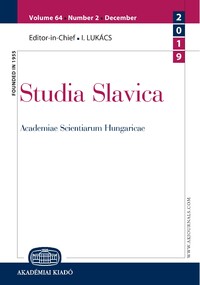The Beginning and the Narration of Ivan Slamnig’s Novel Bolja polovica hrabrosti
The Beginning and the Narration of Ivan Slamnig’s Novel Bolja polovica hrabrosti
Author(s): István LadányiSubject(s): Croatian Literature
Published by: Akadémiai Kiadó
Keywords: postmodern novel; jeans prose; Beat literature; story within a story; constructedness; coincidence; implied author; implied reader; homodiegetic narration; heterodiegetic narration
Summary/Abstract: The study discusses Ivan Slamnig’s novel entitled Bolja polovica hrabrosti with focusing on the narrative features of the beginning of the novel. Using the results of the Croatian literary studies, the paper places the novel in the context of Croatian prose as the first postmodern Croatian novel and an outstanding example of Beat literature in Croatia and Yugoslavia, which Aleksandar Flaker called jeans prose. The paper compares the narrative features and metapoetic meanings of the beginning of the novel with the narration of the whole novel and its closure. It establishes that the beginning of the novel gives a dominant role to eventuality, coincidence, and meaninglessness instead of causally motivated storytelling. The beginning of the novel does not make sense at the level of the story told in the whole novel, however, it is important at the metalevel of narration and in its possible readings. The main character of the novel called Flaks lands without a known aim aft er escaping from somewhere. At the end of the novel, he escapes again from the story prescribed for him. The “story within a story” structure has an important role in the novel. The novel thus has two narrators and two narrated stories. According to Genette’s classification, the narrator of the whole novel (Flaks) is an extradiegetic-homodiegetic narrator of his own story. The other narrator (Aunt Matilda) is a character in Flaks’s story and fictive author of the embedded story with its own heterodiegetic narrator. Flaks is an implied reader of Matilda’s short story. The two narratives are in a metadialogue wiTheach other. Flaks has no organized life and no organized story. Matilda’s life is well organized, and her written short story is well organized, too. Matilda tries to make sense to the random happenings of Flaks’s life in her own story. With the story she tells, she tries to bring both her own and Flaks’s life story to a meaningful end. The beginning of the novel is associated with the characteristics of the Yugoslavian version of Beat literature, the jeans prose: generational confrontation and the denial of conformism to the post-war Yugoslavian establishment. The protagonist’s drift ing without any plan, which is typical for the genre, is taken by Slamnig as a basis so that he can direct our attention to the activity of the implied author and to the fact that the events portrayed in the novel and also the implied author are constructed. This is reinforced by the “story within a story” structure. The novel shows that the beginning and the ending of the events in the narration is arbitrary, and the meaning of the story depends on the selection of the starting point and the end point.
Journal: Studia Slavica Academiae Scientiarum Hungaricae
- Issue Year: 65/2020
- Issue No: 1
- Page Range: 107-113
- Page Count: 7
- Language: English

